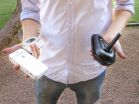(Press-News.org) A massive new University of Colorado Boulder study indicates there is a statistical link between hotter temperatures generated by climate change and the risk of armed conflicts in sub-Saharan Africa.
CU-Boulder Professor John O'Loughlin led a research team that assessed more than 78,000 armed conflicts between 1980 and 2012 in the Sahel region of Africa - a semi-arid belt just south of the Saharan Desert that spans about 3,000 miles and more than a dozen countries from the Atlantic to the Indian oceans.
The team was looking for links between armed conflicts and temperature and rainfall anomalies, as well as assessing other causes of violence in the Sahel. "We found a clear signal that higher temperatures in the Sahel over time does increase the risk of conflict," O'Loughlin said.
While there are growing academic and public policy debates on the effect global climate change may be having on armed conflict in Africa, the link between climate and conflict in the Sahel does not hold true for the entire continent, said O'Loughlin, a professor of distinction in CU-Boulder's geography department. Even in the Sahel, political, economic and geographic factors were more of an influence on conflict than climate.
A paper on the subject appears this week in the Proceedings of the National Academy of Sciences (PNAS). The study was co-authored by CU-Boulder postdoctoral researcher Andrew Linke and University of Alaska Anchorage Assistant Professor Frank Witmer, a former CU-Boulder graduate student who received his doctorate under O'Loughlin. The National Science Foundation (NSF) funded the study.
The study also showed areas in the Sahel that were wetter or dryer than long-term averages were neither more nor less likely to experience violent conflict, he said. "This is an important finding because global climate change often results in environmental changes outside the realm of temperature increases," O'Loughlin said.
"Increasing frequency or greater severity of warmer temperatures could be problematic for the security of populations in regions where the link is statistically significant," said Linke. "But it's important to remember that our study shows that a number of other social forces have strong influences on political violence and conflict."
The new research follows a 2012 PNAS study led by O'Loughlin that indicated the risk of human conflict in East Africa from 1990 to 2009 increased somewhat with hotter temperatures and dropped a bit with higher precipitation. That study, which charted about 26,000 instances of conflict, also showed socioeconomic, political and geographic factors played a larger role in armed conflicts than climate change.
For the new study the research team divided the African continent into thousands of geographic grid cells, each about 6,214 square miles (10,000 square kilometers), examining them individually for both conflict and climate data, said O'Loughlin, also a faculty research associate at CU-Boulder's Institute of Behavioral Sciences.
O'Loughlin said the link between climate and violent conflict is strongest for "communal incidents" - violence between groups of civilians, rather than large-scale civil wars where rebel groups battle government armies.
The exhaustive database of violent events in the Sahel from 1980 to 2012 was assembled in part by CU-Boulder undergraduates, who combed online information sources like LexisNexis, a corporation that pioneered the electronic accessibility of legal and newspaper documents. The work by the students -- who put thousands of hours into the project -- was funded by the NSF's Research Experience for Undergraduates (REU) and has generated several undergraduate honors theses, O'Loughlin said.
The CU-Boulder students coded each conflict event with very specific data, including geographic location coordinates, dates, people and descriptive classifications. The event information was then aggregated into months and into the grid cells that served as the units of analysis for quantitative modeling.
Each conflict grid also was coded by socioeconomic and political characteristics like distance to an international border, capital city, local population size, well-being as measured by infant mortality, the extent of political rights, presidential election activity, road network density, vegetation condition and ethnic community inclusion into the national government. The National Center for Atmospheric Research in Boulder and the University of East Anglia in Norwich, England, provided climate data for the study.
Data also came from the Armed Conflict Location and Event Dataset (ACLED), directed by Clionadh Raleigh of Trinity College in Dublin. That database covers individual conflicts from 1997 to 2009 in Africa and parts of Asia and Haiti. There are more than 60,000 violent incidents in the database to date. Raleigh started the data collection while earning her doctorate at CU in 2007 under O'Loughlin.
As a next step, O'Loughlin has undertaken a new NSF-funded study with CU-Boulder anthropology Professor Terrence McCabe and political science Professor Jaroslav Tir to look at the mechanisms of conflict in Kenya. Researchers are interviewing Kenyans about their experiences regarding both violence and climate change, including the severity and frequency of drought. The study will include data on human migrations as well as the welfare of pastoralists and farmers as a result of climate change, he said.
INFORMATION:
HOUSTON - (Nov. 10, 2014) - An analysis of more than 100 health insurance plans across Texas offered under the Affordable Care Act (ACA) shows that plans can differ significantly in premium cost and the number of hospitals included in insurance networks. That's just one of the findings of a report released today by the Episcopal Health Foundation and Rice University's Baker Institute for Public Policy.
The report examined "Silver" health insurance plans offered by insurers within the ACA's Marketplace. Texas is divided into 26 different geographic areas, with different ...
Philadelphia, PA, November 10, 2014 - Beta-blockers have been a cornerstone in the treatment of heart attack survivors for more than a quarter of a century. However, many of the data predate contemporary medical therapy such as reperfusion, statins, and antiplatelet agents, and recent data have called the role of beta-blockers into question. Two new studies published in The American Journal of Medicine evaluated the traditional management of these patients after their discharge from the hospital and in the light of changing medical treatment, as well as the impact of the ...
The adult human body is made up of about 37 trillion cells. Microbes, mainly bacteria, outnumber body cells by 10 to 1. Increasingly, scientists recognize that this huge community of microbes, called the microbiome, affects the health, development and evolution of all multicellular organisms, including humans.
Studies show symbiotic microbes can help prevent infection by disease-causing pathogens. But sometimes the interaction goes the other way, with a pathogen or disease disrupting the normal community of symbiotic bacteria. In a new study, a team of scientists from ...
ANN ARBOR--In a step toward robots smaller than a grain of sand, University of Michigan researchers have shown how chains of self-assembling particles could serve as electrically activated muscles in the tiny machines.
So-called microbots would be handy in many areas, particularly medicine and manufacturing. But several challenges lie between current technologies and science fiction possibilities. Two of the big ones are building the 'bots and making them mobile.
"We are inspired by ideas of microscopic robots," said Michael Solomon, a professor of chemical engineering. ...
BUFFALO, N.Y. - Most people rarely sing publicly outside of a duty-bound rendition of "Happy Birthday." And since that particular song is usually offered as a group performance, even the reluctant join in the spirit of the occasion, hoping their individual shortcomings will be cloaked by the chorus.
"I can't sing," says the hesitant performer. But a University at Buffalo psychologist believes that most people are not as bad at singing as they might think and he is collaborating on the development of an online test that will evaluate participants' ability to match specific ...
Boulder, Colo. -- Nov. 10, 2014 -- When the double asteroid Patroclus-Menoetius passed directly in front of a star on the night of Oct. 20, a team of volunteer astronomers across the U.S. was waiting.
Observing the event, known as an occultation, from multiple sites where each observer recorded the precise time the star was obscured, yielded the first accurate determination of the two objects' size and shape. The analysis was led by Dr. Marc W. Buie, staff scientist in Southwest Research Institute's (SwRI) Space Studies Department in Boulder, Colo.
The team effort was ...
Scientists at the University of Arizona have discovered what might be the closest thing to "baby photos" of our solar system. A young star called HD 95086 is found to have two dust belts, analogous to the asteroid and Kuiper belts in the Solar System, surrounded by a large dust halo that only young planetary systems have.
Similar dust structures are also found around another, slightly older star called HR 8799, where four massive planets occupy the large gap between the two belts. HR 8799, the first star found to host four directly imaged planets, is often referred ...
A new class of apps and wireless devices used by private pilots during flights for everything from GPS information to data about nearby aircraft is vulnerable to a wide range of security attacks, which in some scenarios could lead to catastrophic outcomes, according to computer scientists at the University of California, San Diego and Johns Hopkins University. They presented their findings Nov. 5 at the 21st ACM Conference on Computer and Communications Security in Scottsdale, Ariz.
`
Researchers examined three combinations of devices and apps most commonly used by private ...
Regulation of a single, specific gene in a brain region related to drug addiction and depression is sufficient to reduce drug and stress responses, according to a study conducted at the Icahn School of Medicine at Mount Sinai and published October 27 online in the journal Nature Neuroscience.
The Mount Sinai study focuses on epigenetics, the study of changes in the action of human genes caused, not by changes in DNA code we inherit from our parents, but instead by molecules that regulate when, where and to what degree our genetic material is activated.
Previous research ...
System 05B degenerated into a remnant low pressure area on Nov. 8 and lingered near the east-central coast of India for two days before dissipating on Nov. 10.
The tropical cyclone's western edge spread over land on Sunday, Nov. 9 while the center of the low-level circulation remained over open waters of the Bay of Bengal. On that day, 05B's remnants were centered near 14.0 north latitude and 83.8 east longitude, about 215 miles east-northeast of Chennai, India.
Infrared imagery from satellites on Nov. 9 indicated that the low-level circulation center of the storm was ...



